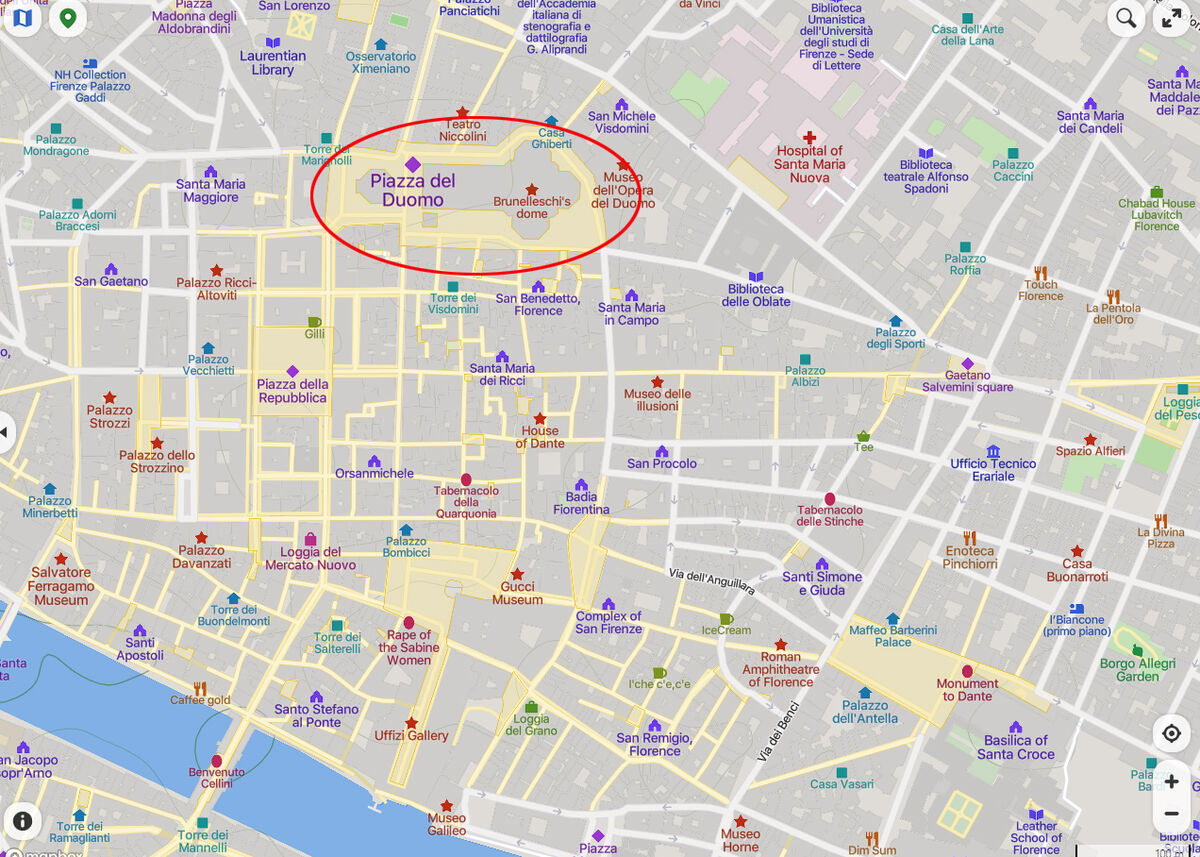Italy: Florence Part 7 - The Piazza Del Duomo
Jul 24, 2023 14:50:55 #
We continued our walk through the Piazza Del Duomo circling the great cathedral. The lines to get in were around the block - even for those who purchased tickets - so we decided not to stand and wait. The cathedral is magnificent from the outside as these images will show.
Piazza del Duomo is the spiritual heart of Florence and the soul of its historic center, declared a Unesco World Heritage Site. The place where you can admire, in a single glance, some of the city's main monuments, in a concentration of history, art and beauty to make your head spin. Indeed, the Cathedral of Santa Maria del Fiore, with the Dome by Brunelleschi, the Bell Tower by Giotto and the Baptistery face each other here, surrounded by historic buildings and small- and large-sized museums.
The space of the present square was on the north side of the Roman quadrilateral, outside it.
From the early Middle Ages, the place became important as the city's religious center, with the presence of a series of buildings that, together, represented the so-called "sacred axis": the bishop's palace, the Baptistery, a hospital, a rectory, a cemetery, and the churches of San Salvatore Al Vescovo, San Michele Visdomini, and Santa Reparata, of early Christian origin. The square was much smaller than it is today, with the bishop's palace abutting the baptistery, and a maze of alleys abutting the monuments.
In the late 13th century, many houses were torn down to make way for the new cathedral and bell tower. In the following centuries Piazza San Giovanni (the "official" name for the space surrounding the baptistery) was also enlarged.
The Complex of Santa Maria del Fiore:
The Cathedral of Santa Maria del Fiore, the Bell Tower by Giotto, the Baptistery, and the Museo dell'Opera del Duomo, with access from No. 9 Piazza Duomo, taken together make up the Complex of Santa Maria del Fiore: more than 700 years of history and beauty gathered in a single square.
The Cathedral, designed by Arnolfo di Cambio on a pre-existing building, is an example of Italian Gothic. Completed in 1367, it was clad in colored marble following the example of the Baptistery, except for the facade, which remained unfinished and found its present appearance only in the 19th century. Inside there are important works of art: the two detached frescoes depicting the equine monuments of the mercenaries Giovanni Acuto and Niccolò da Tolentino, painted by Paolo Uccello (1436) and Andrea del Castagno (1456), respectively; the eight stained glass windows made between 1434 and 1445 based on the drawings by some of the greatest artists of the Florentine Renaissance; and the frescoes by Giorgio Vasari and Federico Zuccari decorating the interior of the Dome by Brunelleschi. What is still today the largest masonry dome ever built is an example of elegance and ingenuity and, from its 90 meters of height and over, gives one of the most beautiful views of Piazza Duomo and the entire city.
The same breathtaking view can be admired from the top of the Bell Tower by Giotto, another splendid testament to 14th-century Florentine Gothic architecture. The exterior decoration represents one of the most complex figurative cycles of the Middle Ages, the work of Florentine masters such as Andrea Pisano, Donatello and Luca Della Robbia.
The Baptistery of San Giovanni, one of the oldest places of worship in Florence, features a fascinating geometric structure with an octagonal plan, is entirely covered with white and green marble from Prato, and is enriched by three magnificent gilded bronze portals (the originals are now in the Museo dell'Opera del Duomo). Inside, an extraordinary mosaic embellishes the ceiling.
The Museo dell'Opera del Duomo houses the world's largest collection of sculpture from the Florentine Middle Ages and Renaissance, with masterpieces by the greatest artists of the time. In the Sala del Paradiso is a life-size recreation of the facade of the Duomo designed by Arnolfo di Cambio in 1296, never completed and finally dismantled in 1587.
Here are the palaces that overlook Piazza Duomo and which you encounter proceeding clockwise, starting from the entrance to the Museo dell'Opera del Duomo, at the back of the Cathedral.
The first is Palazzo Guadagni Sacrati Strozzi, one of the most significant expressions of Florentine civil architecture of the Baroque period, with interiors rich in frescoes and fine decorations. Since 1988 it has been the seat of the Presidency of the Provincial Council of the Region of Tuscany.
On the southern side of the Cathedral stand the Palazzi dei Canonici, a complex of three 19th-century buildings erected following the removal of ancient constructions that were demolished to widen the square. The facade of the central building is easily recognized by the two niches containing the statues depicting the architects of the Cathedral - Arnolfo di Cambio and Filippo Brunelleschi - both by Luigi Pampaloni.
The ambulances that are generally parked right there in front of them indicate the presence of the Palazzo della Misericordia (or Palazzo degli Uffiziali dei Pupilli), since 1576 the seat of the Venerable Arcicompagnia della Misericordia of Florence, an ancient congregation established in1244 to care for the sick and bury the dead, still active today. Inside is an oratory and the new Museo della Misericordia: a 14-room itinerary illustrating the history of the Confraternity and its bond with Florence through archival documents, art objects from bequests and donations, and films.
On the corner with Via Calzaiuoli is the former seat of the Compagnia della Misericordia, which became the property of the Compagnia del Bigallo after a series of adverse circumstances. The building, equipped with a Loggia, now houses the Museo del Bigallo.
Rising imposingly from the side of the Baptistery is the Palazzo Arcivescovile, the residence of the archbishop of Florence and the seat of the diocesan curia, a monumental building that is part of the national artistic heritage. Originally, the palace consisted of two buildings - "Vescovado Nuovo" at the current site and "Vescovado Vecchio", closer to the Baptistery - divided by Via dell'Arcivescovado and connected by an overpass. The Vescovado Vecchio was largely destroyed in 1533 by fire; it was reconstructed (1573 - 1584) thanks to to the initiative of Alessandro Ottavio de' Medici (who would become Pope Leo XI) and the work of the architect Giovanni Antonio Dosio; the "redevelopment" interventions in the Florentine historic town center carried out in the late 19th century eventually led to its demolition, the disappearance of Via dell'Arcivescovado and the enlargement of the square.
Palazzo Gondi, at No. 12r, houses a small-sized corporate museum, the Museo Torrini, dedicated to the history of the Torrini Goldsmith Lineage (1369): about 200 precious objects, a collection of pocket watches, photos, drawings and rare documents, including the original 1568 edition of Treatises on Goldsmithing by Benvenuto Cellini.
One last curiosity: on the facade of Palazzo Naldini, at the corner with Via dei Servi, a plaque and a bust recall that here "furono le botteghe del sommo scultore," (were the workshops of the supreme sculptor) and the reference is to Donatello.
https://www.visittuscany.com/en/attractions/the-piazza-del-duomo-in-florence/
For narrative on Florence and additional images, please see my previous posts:
https://www.uglyhedgehog.com/t-780452-1.html
https://www.uglyhedgehog.com/t-780574-1.html#14042094
https://www.uglyhedgehog.com/t-780644-1.html
https://www.uglyhedgehog.com/t-780747-1.html#14046442
https://www.uglyhedgehog.com/t-780857-1.html
https://www.uglyhedgehog.com/t-781066-1.html#14052114
I hope you enjoy these!
Mark
Piazza del Duomo is the spiritual heart of Florence and the soul of its historic center, declared a Unesco World Heritage Site. The place where you can admire, in a single glance, some of the city's main monuments, in a concentration of history, art and beauty to make your head spin. Indeed, the Cathedral of Santa Maria del Fiore, with the Dome by Brunelleschi, the Bell Tower by Giotto and the Baptistery face each other here, surrounded by historic buildings and small- and large-sized museums.
The space of the present square was on the north side of the Roman quadrilateral, outside it.
From the early Middle Ages, the place became important as the city's religious center, with the presence of a series of buildings that, together, represented the so-called "sacred axis": the bishop's palace, the Baptistery, a hospital, a rectory, a cemetery, and the churches of San Salvatore Al Vescovo, San Michele Visdomini, and Santa Reparata, of early Christian origin. The square was much smaller than it is today, with the bishop's palace abutting the baptistery, and a maze of alleys abutting the monuments.
In the late 13th century, many houses were torn down to make way for the new cathedral and bell tower. In the following centuries Piazza San Giovanni (the "official" name for the space surrounding the baptistery) was also enlarged.
The Complex of Santa Maria del Fiore:
The Cathedral of Santa Maria del Fiore, the Bell Tower by Giotto, the Baptistery, and the Museo dell'Opera del Duomo, with access from No. 9 Piazza Duomo, taken together make up the Complex of Santa Maria del Fiore: more than 700 years of history and beauty gathered in a single square.
The Cathedral, designed by Arnolfo di Cambio on a pre-existing building, is an example of Italian Gothic. Completed in 1367, it was clad in colored marble following the example of the Baptistery, except for the facade, which remained unfinished and found its present appearance only in the 19th century. Inside there are important works of art: the two detached frescoes depicting the equine monuments of the mercenaries Giovanni Acuto and Niccolò da Tolentino, painted by Paolo Uccello (1436) and Andrea del Castagno (1456), respectively; the eight stained glass windows made between 1434 and 1445 based on the drawings by some of the greatest artists of the Florentine Renaissance; and the frescoes by Giorgio Vasari and Federico Zuccari decorating the interior of the Dome by Brunelleschi. What is still today the largest masonry dome ever built is an example of elegance and ingenuity and, from its 90 meters of height and over, gives one of the most beautiful views of Piazza Duomo and the entire city.
The same breathtaking view can be admired from the top of the Bell Tower by Giotto, another splendid testament to 14th-century Florentine Gothic architecture. The exterior decoration represents one of the most complex figurative cycles of the Middle Ages, the work of Florentine masters such as Andrea Pisano, Donatello and Luca Della Robbia.
The Baptistery of San Giovanni, one of the oldest places of worship in Florence, features a fascinating geometric structure with an octagonal plan, is entirely covered with white and green marble from Prato, and is enriched by three magnificent gilded bronze portals (the originals are now in the Museo dell'Opera del Duomo). Inside, an extraordinary mosaic embellishes the ceiling.
The Museo dell'Opera del Duomo houses the world's largest collection of sculpture from the Florentine Middle Ages and Renaissance, with masterpieces by the greatest artists of the time. In the Sala del Paradiso is a life-size recreation of the facade of the Duomo designed by Arnolfo di Cambio in 1296, never completed and finally dismantled in 1587.
Here are the palaces that overlook Piazza Duomo and which you encounter proceeding clockwise, starting from the entrance to the Museo dell'Opera del Duomo, at the back of the Cathedral.
The first is Palazzo Guadagni Sacrati Strozzi, one of the most significant expressions of Florentine civil architecture of the Baroque period, with interiors rich in frescoes and fine decorations. Since 1988 it has been the seat of the Presidency of the Provincial Council of the Region of Tuscany.
On the southern side of the Cathedral stand the Palazzi dei Canonici, a complex of three 19th-century buildings erected following the removal of ancient constructions that were demolished to widen the square. The facade of the central building is easily recognized by the two niches containing the statues depicting the architects of the Cathedral - Arnolfo di Cambio and Filippo Brunelleschi - both by Luigi Pampaloni.
The ambulances that are generally parked right there in front of them indicate the presence of the Palazzo della Misericordia (or Palazzo degli Uffiziali dei Pupilli), since 1576 the seat of the Venerable Arcicompagnia della Misericordia of Florence, an ancient congregation established in1244 to care for the sick and bury the dead, still active today. Inside is an oratory and the new Museo della Misericordia: a 14-room itinerary illustrating the history of the Confraternity and its bond with Florence through archival documents, art objects from bequests and donations, and films.
On the corner with Via Calzaiuoli is the former seat of the Compagnia della Misericordia, which became the property of the Compagnia del Bigallo after a series of adverse circumstances. The building, equipped with a Loggia, now houses the Museo del Bigallo.
Rising imposingly from the side of the Baptistery is the Palazzo Arcivescovile, the residence of the archbishop of Florence and the seat of the diocesan curia, a monumental building that is part of the national artistic heritage. Originally, the palace consisted of two buildings - "Vescovado Nuovo" at the current site and "Vescovado Vecchio", closer to the Baptistery - divided by Via dell'Arcivescovado and connected by an overpass. The Vescovado Vecchio was largely destroyed in 1533 by fire; it was reconstructed (1573 - 1584) thanks to to the initiative of Alessandro Ottavio de' Medici (who would become Pope Leo XI) and the work of the architect Giovanni Antonio Dosio; the "redevelopment" interventions in the Florentine historic town center carried out in the late 19th century eventually led to its demolition, the disappearance of Via dell'Arcivescovado and the enlargement of the square.
Palazzo Gondi, at No. 12r, houses a small-sized corporate museum, the Museo Torrini, dedicated to the history of the Torrini Goldsmith Lineage (1369): about 200 precious objects, a collection of pocket watches, photos, drawings and rare documents, including the original 1568 edition of Treatises on Goldsmithing by Benvenuto Cellini.
One last curiosity: on the facade of Palazzo Naldini, at the corner with Via dei Servi, a plaque and a bust recall that here "furono le botteghe del sommo scultore," (were the workshops of the supreme sculptor) and the reference is to Donatello.
https://www.visittuscany.com/en/attractions/the-piazza-del-duomo-in-florence/
For narrative on Florence and additional images, please see my previous posts:
https://www.uglyhedgehog.com/t-780452-1.html
https://www.uglyhedgehog.com/t-780574-1.html#14042094
https://www.uglyhedgehog.com/t-780644-1.html
https://www.uglyhedgehog.com/t-780747-1.html#14046442
https://www.uglyhedgehog.com/t-780857-1.html
https://www.uglyhedgehog.com/t-781066-1.html#14052114
I hope you enjoy these!
Mark
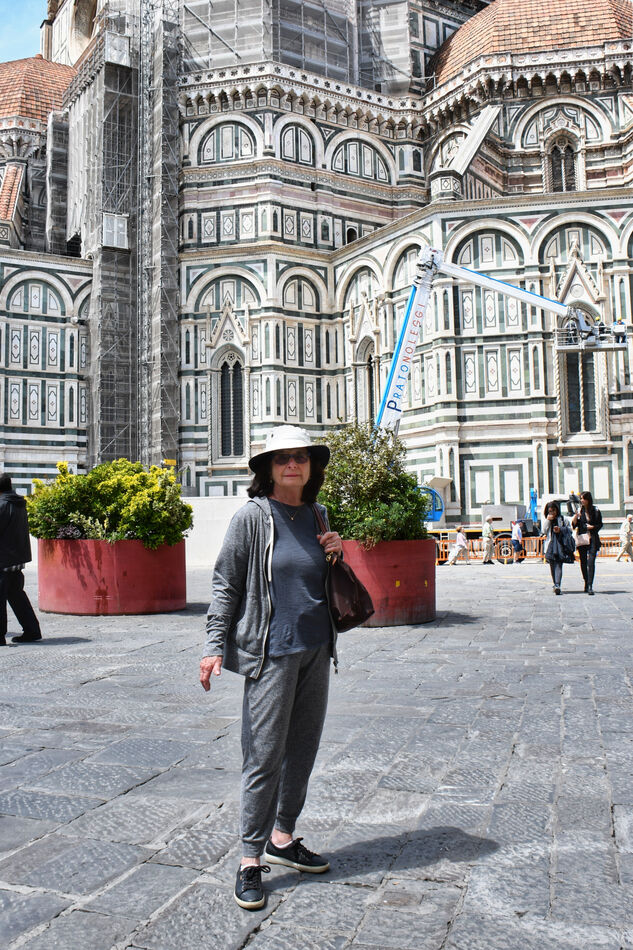
(Download)

(Download)

(Download)
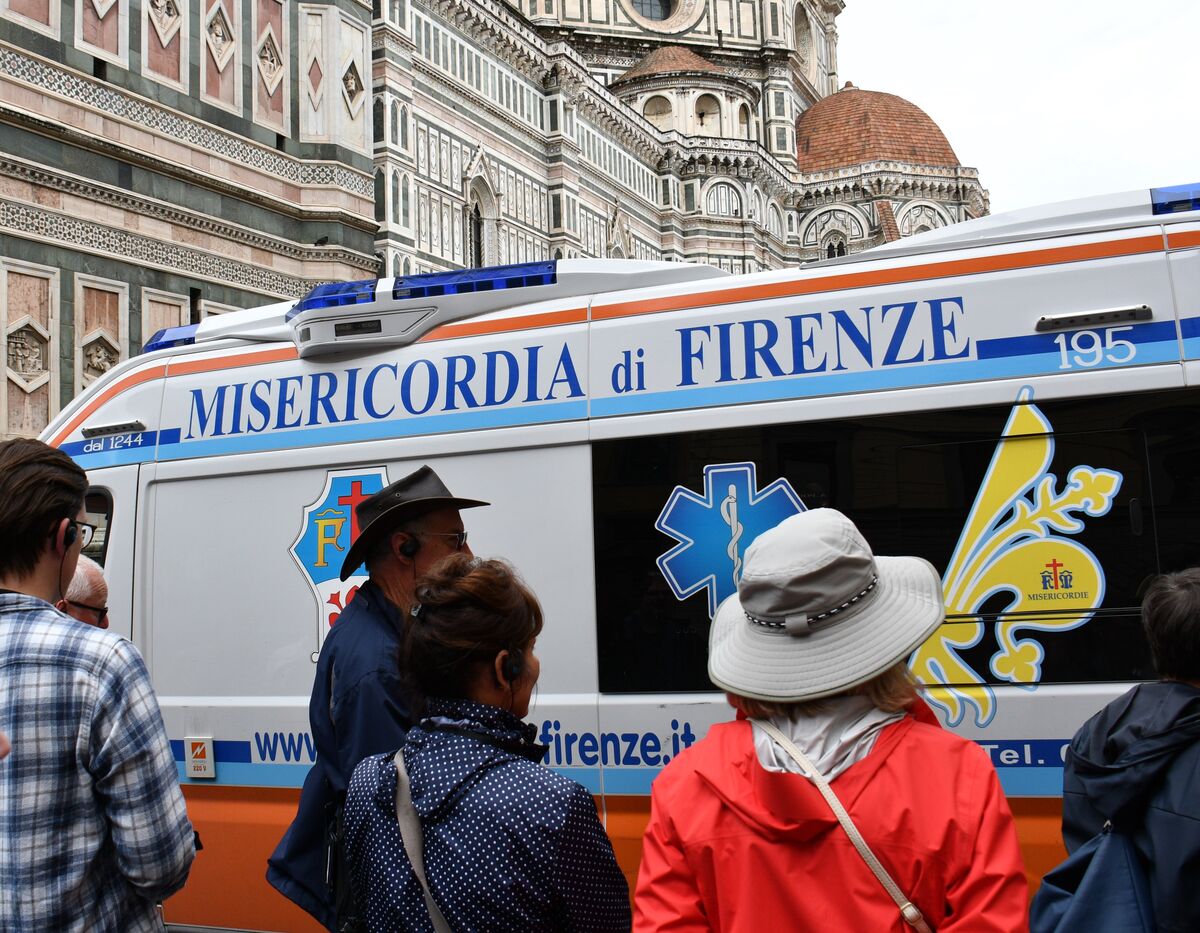
(Download)
The Baptistery of San Giovanni
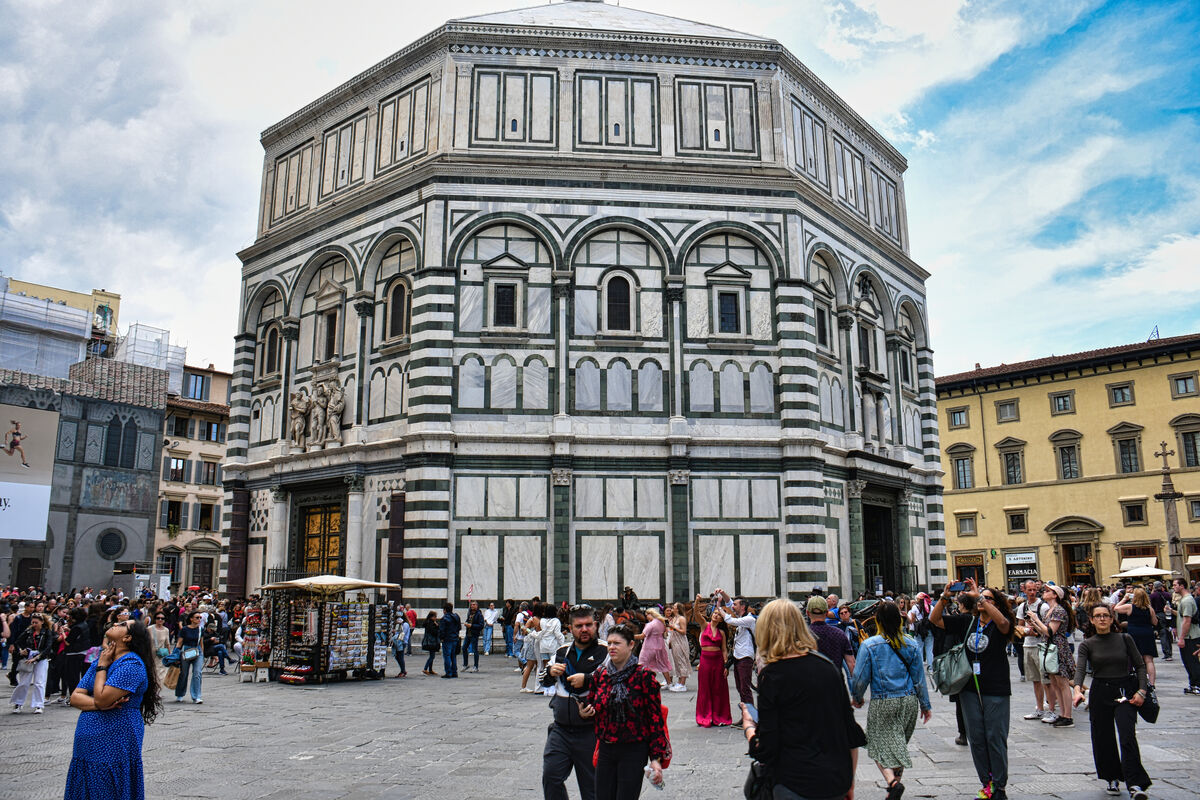
(Download)
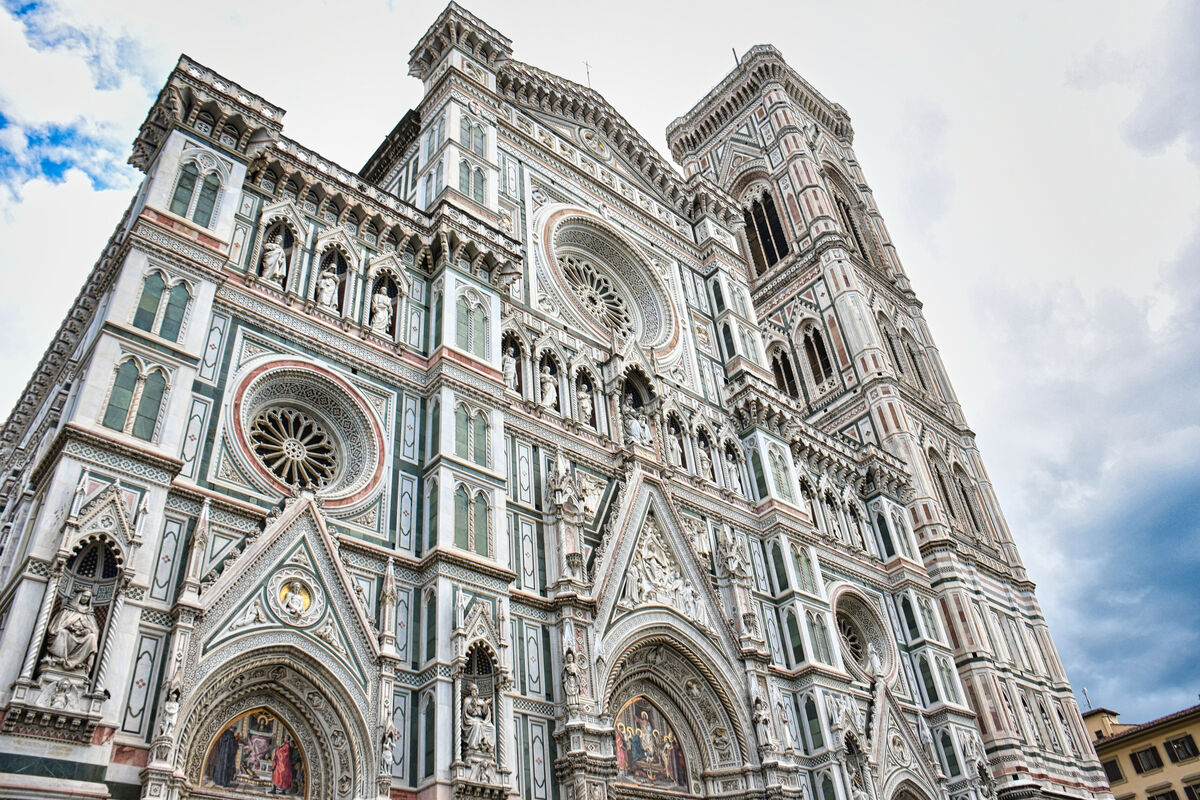
(Download)
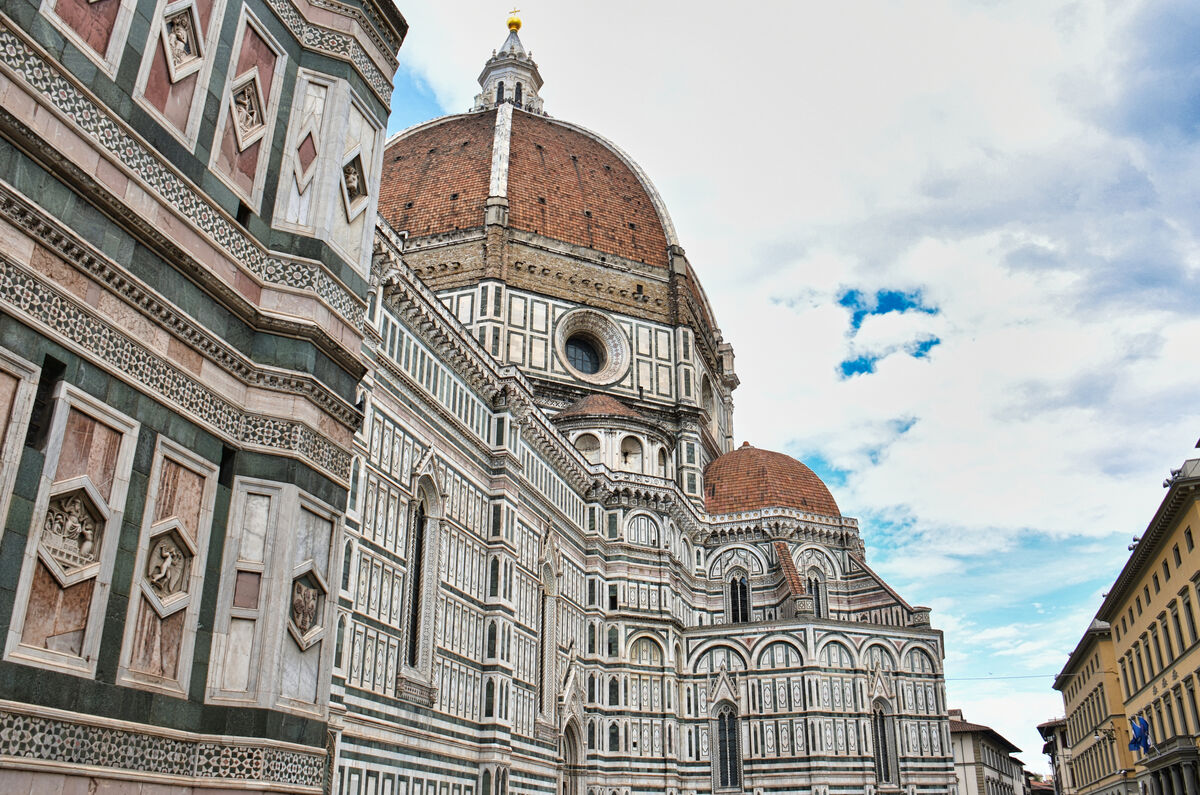
(Download)
The bell tower of Giotto
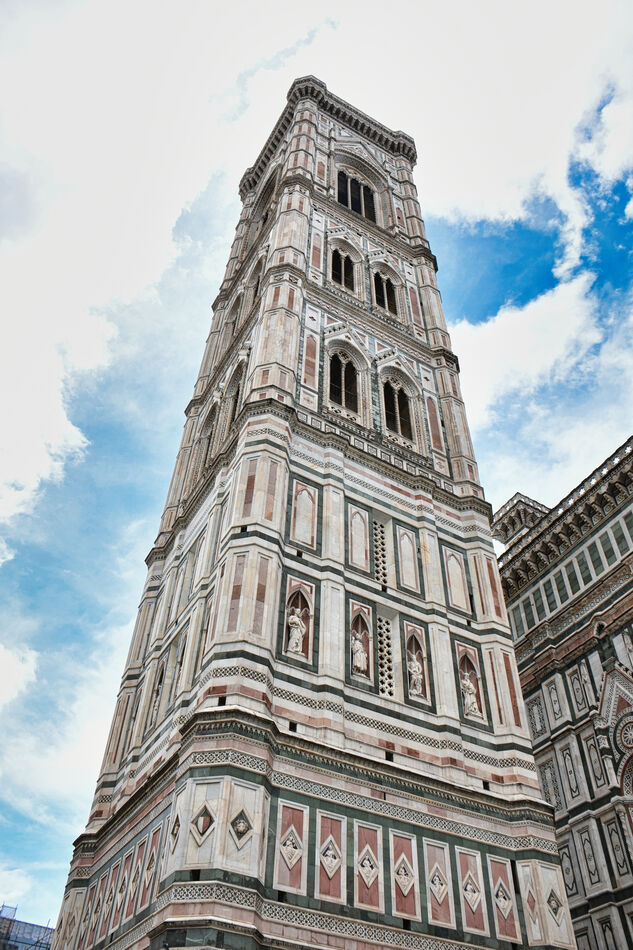
(Download)
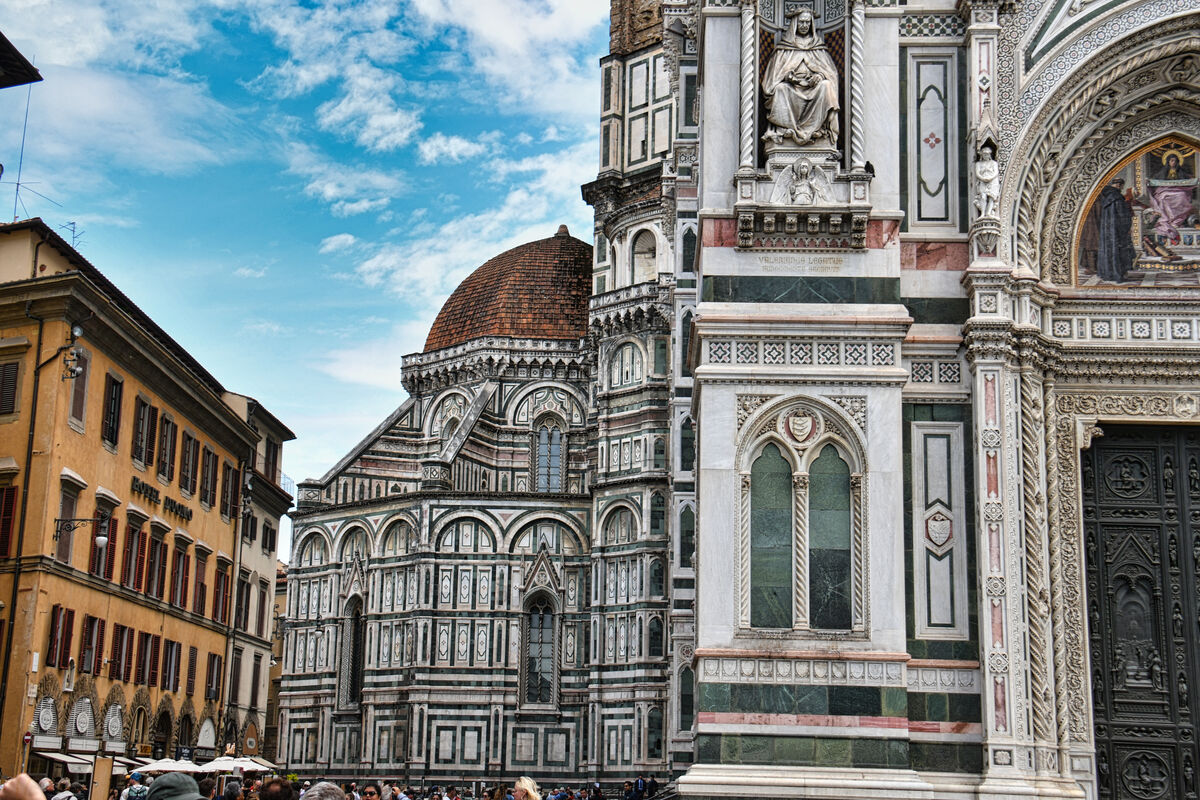
(Download)
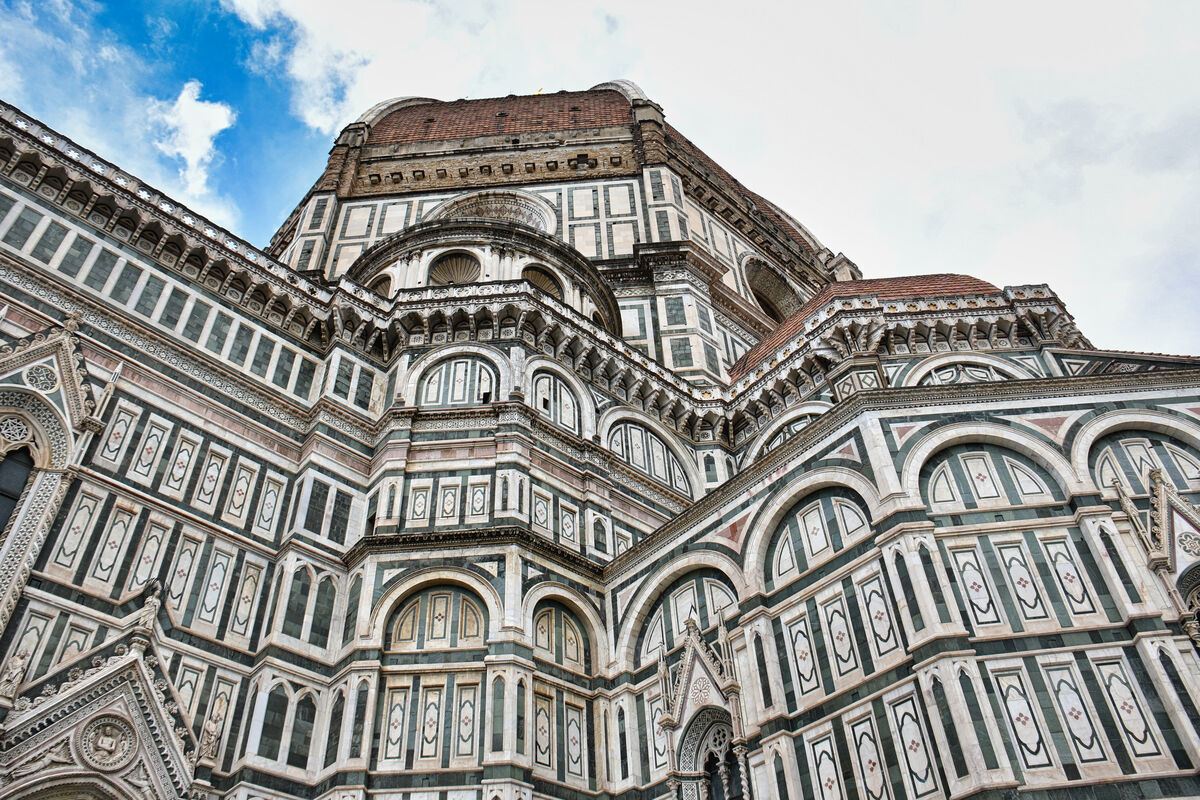
(Download)
Jul 24, 2023 14:51:39 #
Jul 24, 2023 15:15:20 #
Jul 24, 2023 15:22:32 #
Jul 24, 2023 15:24:11 #
srfmhg wrote:
We continued our walk through the Piazza Del Duomo... (show quote)
daughter and family just came back son in law is Italian born in Milan, they went to Rome, Florence and Venice I think then on to Milan their photos are not a good as yours
Jul 24, 2023 15:57:10 #
Jul 24, 2023 16:12:51 #
Jul 24, 2023 16:39:40 #
srfmhg wrote:
We continued our walk through the Piazza Del Duomo... (show quote)
Pure magnificence 🎯🎯🎯🎯🎯
Jul 24, 2023 17:24:44 #
Jul 24, 2023 17:47:51 #
Jul 24, 2023 18:03:56 #
Jul 24, 2023 18:52:03 #
UTMike wrote:
Beautiful tour, Mark! The crowds do not make it easy.
Thanks very much Mike. The crowds were opressive as you'll see in future posts.
Jul 24, 2023 18:53:30 #
catgirl wrote:
daughter and family just came back son in law is Italian born in Milan, they went to Rome, Florence and Venice I think then on to Milan their photos are not a good as yours
Thanks very much Catgirl. We were lucky to miss the heatwave.
Jul 24, 2023 18:54:02 #
Jul 24, 2023 18:54:19 #
If you want to reply, then register here. Registration is free and your account is created instantly, so you can post right away.

